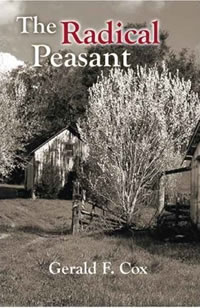Book Notes
 Gerald F. Cox, The Radical Peasant (Trafford Publishing, 2006), 166pp.
Gerald F. Cox, The Radical Peasant (Trafford Publishing, 2006), 166pp.
Charles Philipps? Father Charles Philipps? Who is Father Charles Philipps? There was a time in the history of the Archdiocese when this question could have been answered by just about anyone. Today, however, the memory of Father Philipps has faded, though his legacy has not. Gerald Cox has done the local church a great service by providing a splendid memoir/biography of this great priest. Philipps was an uncompromising advocate for the poor and a champion of the Church’s teaching on social justice.
Charles Philipps was born September 17, 1881 in Stundwiller, Alsace, France. In 1911, he was ordained a priest and immigrated to the United States the same year. When Philipps arrived in San Francisco, the Archdiocese covered a vast expanse, consisting of the thirteen Bay Area counties, which included a good deal of farm land. From his first pastorate in Hughson in 1921 to his final pastorate at St. Mary’s in West Oakland (1936–1950), Philipps stood up for the small farmer, family farms, and the migrant farm worker. Upon his arrival as pastor in Sebastopol in 1930 at the outset of the Great Depression, Philipps encouraged the farmers to establish cooperatives and was instrumental in the creation of the Farmers’ Protective League. In 1933 he became director of the archdiocesan Catholic Rural Life Conference, a position he held until 1952, and was actively involved in the National Catholic Rural Life Conference (NCRLC). Philipps regularly advocated for family farms, encouraging a 160 acre limit on farms, descrying California’s massive agribusiness and corporate farming and the organization of large farmers whom he dubbed the ASS-ociated Farmers. Philipps regularly testified before state and federal agencies with his usual bluntness. Cox dubbed Philipps the “radical peasant,” as his strident views on farming, grounded in the papal social encyclicals, rankled many. One farmer in Sebastopol observed, “If he wasn’t a Catholic priest, he would have been tarred and feathered a long time ago”(30). And the Director of the NCRLC, Luigi Ligutti, wrote to Philipps, “I am very happy that you have been accused of being a Communist again. After all, such accusations must come your way now and then, or you would be failing in the main purpose of your life. Keep it up, I think we’ll meet a lot of Communists like you in heaven” (84).
Philipps also was a strong advocate for the appropriate care of the migrant farm worker and bracero. He was known as the “Godfather” of the Spanish Mission Band, four priests assigned to minister directly to the migrant worker. The Band was instrumental in the success of Cesar Chavez and Dolores Huerta.
Philipps' most memorable quip evolved from his work with the Heifer International project which sought to provide cows for a decimated Europe following World War II. When the Rector of the St. Patrick’s Seminary suggested that Philipps would do better to send tractors and farming equipment instead of cows, Philipps responded, “Well, Father, that is not a bad idea, but the fact is that tractors don’t s--t.” (p. 99). The response has lived on in clerical lore ever since.
Beyond being an advocate for rural life, Philipps also became a strong advocate for the urban poor and immigrants in Oakland. Unlike many pastors of the era, Philipps did not insist his immigrant parishioners learn English, rather he learned their language. He sent his assistant pastor to Mexico to learn Spanish. Philipps spoke six languages fluently. In addition, while he was at St. Mary’s he brought in the Sisters of Social Service for settlement work, established a soup kitchen, a free breakfast program for children, and most significantly, Sunshine Camp, a summer camp for inner city youth on the Russian River. Each year children from West Oakland and the Fillmore in San Francisco escaped to the beloved camp on the river. The camp was staffed by seminarians and survived on donations alone. It was built by hard work. As Cox observes of Philipps, “Charlie considered human sweat almost as a sacramental sign of wholeness and holiness.” He would ask the seminarians, “Are you here to smile or to sweat?” (60). At the camp, hundreds of boys and girls had an experience of the Church that was hard to duplicate or to forget.
Philipps died on July 18, 1958 at the age of 76. He had influenced the lives of many lay and clergy. As Cox admits, “Whenever I am confronted with the injustices of society, Charlie’s face looms up in front of me” (120). Philipps’ life and example inspired many to become social activists.
Deacon Jeffrey M. Burns, PhD
Archivist, Archdiocese of San Francisco
This review first appeared in and is taken from Catholic San Francisco, June 22, 2007, page 20, and is used by permission.


